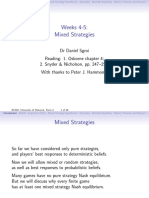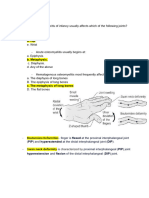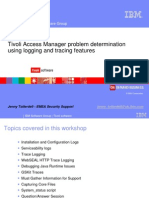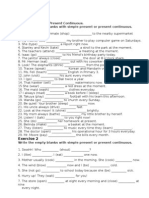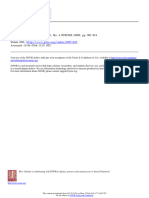MCQ Part 1 2003
MCQ Part 1 2003
Uploaded by
Jhonn NaiseCopyright:
Available Formats
MCQ Part 1 2003
MCQ Part 1 2003
Uploaded by
Jhonn NaiseOriginal Description:
Copyright
Available Formats
Share this document
Did you find this document useful?
Is this content inappropriate?
Copyright:
Available Formats
MCQ Part 1 2003
MCQ Part 1 2003
Uploaded by
Jhonn NaiseCopyright:
Available Formats
MCQ Part 1 2003 1. Regarding fracture healing in children: A Union is faster in toddlers than in adolescents.
B Faster healing is attributable to the thickened periosteum. C Type-V physeal injuries are associated with limb lengthening after union. D Rotational deformity is spontaneously corrected by remodeling process. E Union in the upper limb is faster than the lower limb. 2 A comminuted fracture with a large butterfly fragment is biomechanically produced by the following forces: A Tensile. B Compression. C Bending. D Shearing. E Torsion. 3. The following are true regarding shock: A A restless patient should be treated with sedatives. B A low urine output with high specific gravity indicates the need for more transfusion. C The patient should be kept sitting up at all times. D Transfusion of Rhesus positive group AB blood should be given in cases of emergency. E Cardiogenic shock mimics presentation of hypovolemic shock. 4. Neuropathic ulcer of the foot is commonly A develops under a metatarsal head. B surrounded by hyperkeratotic skin edges. C painless. D poses pinkish punch-out base that bleeds easily. E associated with warm foot and bounding pulses.
5. The following are true of malignant tumours of the bone: A Primary tumours are more common than metastatic lesions. B Bone pain typically precedes bone swelling. C A raised serum alkaline phosphatase is pathognomonic. D Fine needle aspiration is adequate to confirm the diagnosis. E Limb salvage surgery is the current trend of treatment for all cases. 6. The following are true regarding antibiotics: A A bacteriostatic agent should not be combined with a bactericidal agent. B A combination of bactericidal agents of different class and spectrum of activity produces synergistic effect. C Efficacy in-vitro equals efficacy in-vivo. D Efficacy requires that the plasma concentration exceed the Minimum Bactericidal Concentration (MBC) E Macrolides are mainly effective against gram-negative bacteria. 7. Structures likely to be injured after a valgus force is applied to an extended knee in external rotation position include A medial collateral ligament. B medial meniscus. C anterior cruciate ligament D posterior cruciate ligament. E posterior medial corner. 8. The following are true regarding management of type-III open tibial fractures: A A 5-day course of cephalosporin and aminoglycoside is prescribed. B Primary wound closure after debridement is a relative indication. C Use of titanium implant decreases rate of infection. D Unreamed locked nail for fracture stabilization is a preferred option. E Solid nail is preferred because it resists bending greater than hollow nail.
You might also like
- 4443-Multiple Choice Questions in Orthopaedics and TraumaDocument32 pages4443-Multiple Choice Questions in Orthopaedics and TraumaJunaidahMubarakAli83% (30)
- Multiple Choice Questions in Clinical Radiology: For Medical Practitioners and Medical StudentsFrom EverandMultiple Choice Questions in Clinical Radiology: For Medical Practitioners and Medical StudentsRating: 5 out of 5 stars5/5 (1)
- General Surgery Board Exam QuestionsDocument6 pagesGeneral Surgery Board Exam Questionschristinejoan100% (1)
- AAOS Basic Science (50 Soal)Document10 pagesAAOS Basic Science (50 Soal)Fasa RoshadaNo ratings yet
- All NBDE Questions 2008Document209 pagesAll NBDE Questions 2008Bonnie Seng100% (6)
- FRCS MCQsDocument18 pagesFRCS MCQsmonkeyzerg100% (1)
- March 2022 MCQsDocument17 pagesMarch 2022 MCQsZeeshan Ahmad100% (2)
- A. Ectoderm. B. Mesoderm (Correct Answer) C. Endoderm D. All of The AboveDocument94 pagesA. Ectoderm. B. Mesoderm (Correct Answer) C. Endoderm D. All of The AboveMojahed Al Jaafri100% (1)
- Hernia and Acute Abdomen MCQDocument44 pagesHernia and Acute Abdomen MCQShriyansh Chahar50% (4)
- w04 w05 Mixed StrategiesDocument48 pagesw04 w05 Mixed StrategiesŞimal KöseoğluNo ratings yet
- BioBridge Quick Start Guide - Lenel OnGuard (OpenAccess)Document20 pagesBioBridge Quick Start Guide - Lenel OnGuard (OpenAccess)brandonNo ratings yet
- LingkupDocument10 pagesLingkupmegaaini100% (1)
- حلول جراحه ماينر 11Document14 pagesحلول جراحه ماينر 11Yousif AlaaNo ratings yet
- Soal Ujian Masuk GabunganDocument37 pagesSoal Ujian Masuk GabunganRiyan ArdiansyahNo ratings yet
- Multiple Choice QuestionsDocument7 pagesMultiple Choice QuestionsBD Physiotherapist100% (1)
- Surgery UZ ArchivesDocument11 pagesSurgery UZ ArchivesNoor SeckamNo ratings yet
- Board ExamDocument15 pagesBoard Examwaedhalasa01No ratings yet
- Extremity Trauma (MCQ)Document2 pagesExtremity Trauma (MCQ)DEOGRATIAS NDAYISABANo ratings yet
- Brainstorming-Emerald SeasonDocument11 pagesBrainstorming-Emerald SeasonHaydi Pineda MedinaNo ratings yet
- Q1/ Choose The Most Appropriate AnswerDocument11 pagesQ1/ Choose The Most Appropriate AnswerzainabNo ratings yet
- Ppds Orto Juli 2019Document10 pagesPpds Orto Juli 2019sarwenda annasNo ratings yet
- 100Document17 pages100Dr-Wisam Mhmd Ali100% (1)
- Final Soal JULI 2019Document9 pagesFinal Soal JULI 201960083576RiyanNo ratings yet
- Soal TraumaDocument10 pagesSoal TraumaYoga PribadiNo ratings yet
- Sendup MCQ Paper I 2016 okDocument12 pagesSendup MCQ Paper I 2016 okAhmad RazaNo ratings yet
- Orthopedics Final Exam EhsanDocument12 pagesOrthopedics Final Exam EhsanMohammad Alrefai100% (1)
- OD OS ROENT Complete MergeDocument190 pagesOD OS ROENT Complete MergenickagnzlzNo ratings yet
- Syrgery Mock 2Document8 pagesSyrgery Mock 2aa.No ratings yet
- Block H Proff 2021 by MMCDocument23 pagesBlock H Proff 2021 by MMCmuhammadshayan416No ratings yet
- OrthopaedicsDocument8 pagesOrthopaedicsalmahdiabbas54No ratings yet
- Prometric Ortho 2014Document10 pagesPrometric Ortho 2014moutaz702100% (2)
- Part - Two (1) BLUEDocument36 pagesPart - Two (1) BLUEDr-Mohammad Ali-Fayiz Al TamimiNo ratings yet
- Orthopaedics _student Pdf_2 Dec 2024Document21 pagesOrthopaedics _student Pdf_2 Dec 2024kehaxo6342No ratings yet
- MCQ EBPRM Examination 2010Document23 pagesMCQ EBPRM Examination 2010Amer WasimNo ratings yet
- MCQs For POLYTRAUMA PATIENT IN ADULTDocument2 pagesMCQs For POLYTRAUMA PATIENT IN ADULTdegreefirst28No ratings yet
- Orthopedic MCQ (Group 5)Document4 pagesOrthopedic MCQ (Group 5)Law YouNo ratings yet
- Neurosurgery MCQ'sDocument5 pagesNeurosurgery MCQ'sRajanish Kumar50% (2)
- Recal 2019.Document27 pagesRecal 2019.mussab100% (2)
- Orthopedics Exam 3Document27 pagesOrthopedics Exam 3Sarhan AliNo ratings yet
- Surgery II FinalDocument6 pagesSurgery II FinalPanda PandaNo ratings yet
- MCQ Dental.Document5 pagesMCQ Dental.anuj sharmaNo ratings yet
- Atton's Surgery 4th EdDocument126 pagesAtton's Surgery 4th EdАлександр АртамоновNo ratings yet
- Orthopedics 2021Document11 pagesOrthopedics 2021Mayar MohammadNo ratings yet
- Apk 1998 FebruaryDocument23 pagesApk 1998 FebruaryJem Rhod CamenseNo ratings yet
- NIMHANS PG Paper 2002 Part 1Document3 pagesNIMHANS PG Paper 2002 Part 1Billy ManyadzaNo ratings yet
- March 2023 Past Paper - Zamin Abbas - Auon NiaziDocument28 pagesMarch 2023 Past Paper - Zamin Abbas - Auon NiaziMuhammad HashimNo ratings yet
- Sep 20Document48 pagesSep 20ABDULLAH M RNo ratings yet
- Ceu Pre Board Exam 5 Os Od Radio CompressDocument8 pagesCeu Pre Board Exam 5 Os Od Radio CompressALIAH ZARINAH TAGUDARNo ratings yet
- Mist Orthopaedics Subject Wise Test Pdfs On 02 June 2024Document11 pagesMist Orthopaedics Subject Wise Test Pdfs On 02 June 2024abdulrahimwada786No ratings yet
- January 2020 QuestionsDocument10 pagesJanuary 2020 QuestionsAhmed Saleh100% (2)
- Dutton (Question and Answer)Document38 pagesDutton (Question and Answer)nelsy flores100% (2)
- George MCQ 2010Document9 pagesGeorge MCQ 2010Mohamad RamadanNo ratings yet
- Wound Management Exam QuestionsDocument11 pagesWound Management Exam Questionsdurmoh9No ratings yet
- GMSC Aug1999Document22 pagesGMSC Aug1999Eloisa Cellona100% (1)
- in The Workup On A Patient For Possible Appendicitis, CT Scanning Should Be PerformedDocument9 pagesin The Workup On A Patient For Possible Appendicitis, CT Scanning Should Be PerformedDr-Mohammad Ali-Fayiz Al TamimiNo ratings yet
- Ortho Chennai Test 2020Document4 pagesOrtho Chennai Test 2020ArvindhanNo ratings yet
- Unicompartmental Knee Arthroplasty: Indications, Surgical Techniques and ComplicationsFrom EverandUnicompartmental Knee Arthroplasty: Indications, Surgical Techniques and ComplicationsTad L. GerlingerNo ratings yet
- Hypospadiology, Second Edition: Repairing Hypospadias BetterFrom EverandHypospadiology, Second Edition: Repairing Hypospadias BetterNo ratings yet
- Cartilage Injury of the Knee: State-of-the-Art Treatment and ControversiesFrom EverandCartilage Injury of the Knee: State-of-the-Art Treatment and ControversiesAaron J. KrychNo ratings yet
- Operative Brachial Plexus Surgery: Clinical Evaluation and Management StrategiesFrom EverandOperative Brachial Plexus Surgery: Clinical Evaluation and Management StrategiesAlexander Y. ShinNo ratings yet
- Annual Update in Intensive Care and Emergency Medicine 2020From EverandAnnual Update in Intensive Care and Emergency Medicine 2020No ratings yet
- The Four Boundless QualitiesDocument2 pagesThe Four Boundless QualitiesDarianaBluehandNo ratings yet
- Health Psychology FrenchDocument10 pagesHealth Psychology FrenchLucia VieiraNo ratings yet
- 21ST CenturyDocument13 pages21ST CenturyMiah CanariaNo ratings yet
- Commercial Law Lecture 07-05-2019 PDFDocument12 pagesCommercial Law Lecture 07-05-2019 PDFเจียนคาร์โล การ์เซียNo ratings yet
- Employee Management Test ID Test Inputs Expected Output Actual Output Result (Pass/Fail) Description Employee ProfileDocument7 pagesEmployee Management Test ID Test Inputs Expected Output Actual Output Result (Pass/Fail) Description Employee ProfilePoornami WijekoonNo ratings yet
- Leica Zoom 2000Document6 pagesLeica Zoom 2000HaienasrNo ratings yet
- Specific Gravity of Crude Oil PDFDocument3 pagesSpecific Gravity of Crude Oil PDFANKIT SHARMANo ratings yet
- Buy Side Risk ManagementDocument71 pagesBuy Side Risk ManagementsilentodhkNo ratings yet
- What HappenedDocument14 pagesWhat HappenedNirvana SuggieNo ratings yet
- Foundation 1 - Lesson 1Document54 pagesFoundation 1 - Lesson 1Alamelu Venkatesan100% (1)
- Performance Measurement FrameworkDocument25 pagesPerformance Measurement Frameworklorenzo empleo100% (1)
- Tivoli Access Manager Problem Determination Using Logging and Tracing FeaturesDocument41 pagesTivoli Access Manager Problem Determination Using Logging and Tracing FeaturescotjoeyNo ratings yet
- School Grade Level Teacher Learning Area Teaching Date and Time QuarterDocument24 pagesSchool Grade Level Teacher Learning Area Teaching Date and Time QuarterAnalyn SabunodNo ratings yet
- 50 - Leadership of Culture, Ethics and Diversity-&&Document38 pages50 - Leadership of Culture, Ethics and Diversity-&&Mariam UjmajuridzeNo ratings yet
- Value at Risk As A Tool For Mutual Funds Performance Evaluation PDFDocument6 pagesValue at Risk As A Tool For Mutual Funds Performance Evaluation PDFEka Nurmala SariNo ratings yet
- In Re: Robbyn Dale Mattson and Renee Diane Mattson, 9th Cir. BAP (2012)Document22 pagesIn Re: Robbyn Dale Mattson and Renee Diane Mattson, 9th Cir. BAP (2012)Scribd Government DocsNo ratings yet
- Simple Present or Present Continuos Exercise 1 and 2Document2 pagesSimple Present or Present Continuos Exercise 1 and 2Veronica Tandra100% (10)
- Implementación Proyectos Con myRIO H2 2018Document49 pagesImplementación Proyectos Con myRIO H2 2018Miguel Martin100% (1)
- On Shakespeare's The TempestDocument4 pagesOn Shakespeare's The TempestKeyera BernardNo ratings yet
- Code of Conduct History 1Document3 pagesCode of Conduct History 1Jm MotoNo ratings yet
- Margin Requirement Examples For Sample Options-Based PositionsDocument2 pagesMargin Requirement Examples For Sample Options-Based PositionsOladipupo Mayowa PaulNo ratings yet
- ENGLISH 11 TEST FOR UNIT 4-2Document6 pagesENGLISH 11 TEST FOR UNIT 4-2John NguyễnNo ratings yet
- What The Goals of A Song Leader Should BeDocument2 pagesWhat The Goals of A Song Leader Should BeKevin Arellano Balatico100% (1)
- Ruturaj Arvind Umaranikar 200979009 Assignment 3Document13 pagesRuturaj Arvind Umaranikar 200979009 Assignment 3Ruturaj UmaranikarNo ratings yet
- Media & Law ProjectDocument17 pagesMedia & Law ProjectAshad mansooriNo ratings yet
- Comprehensive IncomeDocument9 pagesComprehensive IncomeJesiah PascualNo ratings yet
- Chapter 4 - Emotion and MoodDocument27 pagesChapter 4 - Emotion and MoodNguyễn Xuân Anh VyNo ratings yet
- PatriotismDocument25 pagesPatriotismdandotiya.yash73No ratings yet









